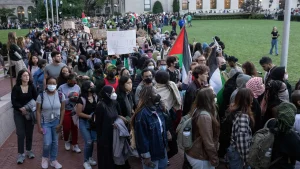Karl Marx and Friedrich Engels published “The Communist Manifesto” in late February 1848 in London. As the manifesto came off the presses, an uprising in Paris toppled the French monarchy. Over the coming months, barricades went up across Europe, from Dublin to Bucharest. The 23-page pamphlet read like the script to a coming age of revolutions.
“The Socialist Manifesto,” which Bhaskar Sunkara presented in Manhattan on April 30, has some formal similarities to its namesake. Both manifestos present a summary of history followed by a short program of immediate demands (of 10 points and 15 points, respectively). The authors share the confidence of youth: Marx was 29 and Engels was 27 when their manifesto appeared, while Sunkara is 29.
That is also where the similarities end. Marx and Engels chose the red star as their symbol. Sunkara has decorated his book with a symbol that can only be found in a political graveyard: the stylized rose has been used by social democratic parties around the world for the last few decades. These parties, which have implemented brutal austerity across Europe, have almost ceased to exist: the Greek PASOK and France’s Parti Socialiste each went from the presidency to just 6% in the most recent elections. The whole Socialist International is rotten: It counts among its members Juan Guaidó, the self-appointed president of Venezuela who is attempting to carry out a coup under the direction of Trump.
It is only in the Anglo-Saxon world that social democratic reformism is experiencing a kind of senile renaissance, pushed by Jeremy Corbyn in the U.K. and Bernie Sanders in the United States (even though the latter insists he is nothing more than a “New Deal liberal”). This is the wave that Sunkara, the founding editor of Jacobin, is riding.
The young publisher, who has established a network of successful left-wing magazines before his 30th birthday, does not share Marx’ bombastic style. Instead, he speaks with the neurotic self-deprecation of a standup comic. This is a language for the millennial generation: friendly, flippant and unpretentious, using a footnote reference to the Backstreet Boys to explain socialism. Sunkara writes that if producing Marxist theory is like cooking fine pasta, then he is making SpaghettiOs. While Marx was famous for mercilessly mocking his opponents, Sunkara is, as American pundits like to say, someone you would like to get a beer with.
Thought Experiments
Sunkara’s book begins with a long thought experiment about life in a “socialist America,” stretching from 2018 to 2038. This introduction—which Sunkara has called the only really good part of the book—envisions President Sanders and a series of increasingly left-wing social democratic governments implementing small changes that would give working people in New Jersey more freedom and more control over their lives. This is in contrast to Marx, who, except for a few stray remarks, consistently refused to speculate about what life under socialism would look like. Leon Trotsky, however, did offer a fascinating vision for a communist America.
If we leave aside all the entertaining references to Jon Bon Jovi, what is striking about Sunkara’s strategic thinking is his apparent conviction that we have an unlimited amount of time to tinker with capitalism. He expects 20 years uninterrupted by capitalist crises, imperialist wars or other inconveniences. It takes 240 pages before he finally remembers to mention climate change, but as California burns and Bangladesh sinks under water, Sunkara remains convinced that we can spend decades and decades attempting to modify the institutions of the capitalist state in order to tame capitalism.
Most of the book consists of a summary of world history. It is incredibly valuable that Sunkara has produced a book with a short history of the international socialist movement that can be found at chain stores and airport bookstores around the country—this will introduce countless young people to a side of U.S. history that many high school and college classes never illuminate. Yet Sunkara’s history is filtered through the lens of American Cold War social democrats like Michael Harrington (whose legacy has been thoroughly criticized by Doug Greene). Without commenting on every point and turn this review into a book of its own, I would like to mention one historical anecdote that stood out to me.
Sunkara dedicates much space to the development of the Social Democratic Party of Germany (SPD), the leading party of the Second International. In 1914, the SPD famously voted to support World War I. This unprecedented massacre shattered the illusion that socialists could overcome capitalism via a slow process of reforms.
The left within the SPD, around Rosa Luxemburg and Karl Liebknecht, called for mass actions (demonstrations and strikes in the cities, as well as fraternization at the front) to end the war. The SPD’s center around Karl Kautsky, in contrast, hoped that they could remain neutral. Kautsky’s goal was to persuade the capitalist governments to end the slaughter quickly so the Social Democracy could resume the process of reforming capitalism.
Sunkara subscribes fully to Kautsky’s view, affirming that the latter’s Independent Social Democratic Party (USPD) “could do little to end a war that killed millions.” This is patently untrue. In the summer of 1916, the first mass strike against the war took place in Germany, with 50,000 Berlin metalworkers taking the streets. By 1918, more than a million workers across the country were on strike demanding an end to the war. These protests, alongside bread riots and revolutionary agitation in the troops, are what convinced the German generals to sue for peace. Just a few months later, millions of workers toppled all the German monarchs. Many of these workers were members of the USPD.
Why could the USPD supposedly “do nothing”? Simply because of the reformist leaders’ obsession with legality and parliamentary methods—because of their “superstitious deference” to the capitalist state, as Engels had called it. Vladimir Lenin, a left critic of Kautsky, addressed this specifically:
Owing to the treachery of their leaders, the masses could not do anything at the crucial moment, whereas this “handful” of leaders were in an excellent position and in duty bound to vote against the war credits, take a stand against a “class truce” and justification of the war, express themselves in favour of the defeat of their own governments, set up an international apparatus for the purpose of carrying on propaganda in favour of fraternisation in the trenches, organise the publication of illegal literature on the necessity of starting revolutionary activities, etc.
Kautsky’s was also very much the method of Harrington during the Vietnam War: He wanted to persuade the White House to end it, so Harrington tried to keep the anti-war movement as moderate and respectable as possible. One worries that Sunkara, faced with the next imperialist war, will also decide that socialists “can do little.”
Our Red Century
The Russian Revolution of 1917 showed how the working class could put an end to the imperialist slaughter of World War I. In February, women from the textile factories went on strike. This inspired workers across the capital, leading to a mass insurrection that toppled the hated czar. The monarchy was replaced by a provisional government that promised democratic reforms, but in reality attempted to continue the war and protect the large landowners. Workers built up their own structures, called councils, or “soviets.” By October, these councils took power in a new insurrection, led by the Bolshevik Party of Lenin and Trotsky. This created the most radically democratic system the world had ever seen: The directly elected representatives of the workers were deciding government policy.
Sunkara correctly rejects the conservative slander that the Russian Revolution was a putsch by a small minority. The Bolshevik party could only take and hold on to power because the working masses supported it. Yet Sunkara repeats the liberal slander that Bolshevism, with all its revolutionary fervor—introducing direct democracy, gender equality, gay rights, abortion rights and a socialist economy to a backward peasant country—led directly to the bureaucratic horrors of Stalinism. In reality, Stalinism represented the defeat of the Bolshevik party and the workers’ councils. Why else would the Stalinists have felt the need to execute hundreds of thousands, including all the leading lights of the revolution? These murders alone make clear that Stalinism was the counterrevolutionary negation of Bolshevism.
Liberal historians praise the February Revolution as “noble” and criticizes the October Revolution for its “excesses.” He also mentions that the provisional government created after the February insurrection continued the pointless war, which cost the lives of 100,000 Russian soldiers over the following half year. The October insurrection, in contrast, ended the war immediately, using appeals to the working people of all countries to take their fates into their own hands. The Russian Revolution remains the best example in history of how the working class, using its own power, can transform society. If it was possible in an agrarian country like Russia, where the working class composed less than 10% of the population, we can only imagine the possibilities when the working class takes power in developed countries like the United States. Yet Sunkara, convinced that the revolution is ultimately to blame for the counterrevolution, has other models in mind.
Seeking Consistent Reformists
Sunkara’s model for the future is … Sweden from the 1970s. Currently, the two front-runners for the 2020 presidential election, Donald Trump and Joe Biden, are promising a return to an entirely mythical “golden age” of American greatness. Sunkara has his own illusions in the distant past, decades before his birth—but these are in Europe. This obsession with the Nordic countries is shared by Sanders and Alexandria Ocasio-Cortez.
Sweden, which Sunkara considers “the most humane social system ever constructed,” offered workers high wages and social security—yet he concedes a few pages later that the country was still owned by “fifteen families” (and entirely neglects to mention that it remains a monarchy.) How did the Nordic welfare state come into being? Yes, a well-organized workers’ movement played a role. But there was also the pressure of the degenerated workers’ states just across the border, reminding workers that another system was possible. At the same time, Swedish imperialism made vast profits by plundering resources from and selling weapons to the poor countries. These imperialist superprofits could subsidize social services. It is no coincidence that racist, right-wing formations are on the rise in all Nordic countries, winning about 20% of votes.
Uninterested in materialist explanations, Sunkara looks to brave reformist leaders like Olaf Palme (prime minister of Sweden, 1969-76, 1982-86) and François Mitterand (president of France, 1981-95) as the source of progressive changes. We learn that these leaders were hard at work on elaborate, step-by-step plans for transferring private companies into public ownership with democratic control. And why did the commissions not even complete their plans, let alone take first steps? Did it have something to do with the fundamental inability of capitalist states to be used against the interests of capital? Does this show the crushing power that the bourgeoisie can bring to bear against any bourgeois government? Who knows? In Sunkara’s thinking, we can just wait a few more decades to see if another reformist champion is more consistent.
Blind Spots
The version of history presented in “The Socialist Manifesto” includes some big blind spots. There is hardly a mention of Salvador Allende (president of Chile, 1970-73), who attempted to implement the exact program of social democratic reforms that Sunkara is advocating. The Chilean military, whom Allende trusted wholeheartedly, was interested not in election results but in defending private property. They toppled Allende in a bloody coup, murdered and exiled 30,000 people.
This experience requires socialists to think seriously how to confront and vanquish the capitalist state. Shockingly, reformists base their strategy on the invincible hope that military officers will accept the will of a socialist majority in parliament. Sunkara goes back and forth on the question of the state, at one point mentioning Marx’ dictum that the working class must smash the capitalist state (which he falsely attributes to Lenin), but also calling for a “strong state” to make capitalism more humane.
While Sunkara proclaims his solidarity with a number of left-wing parties in Europe—Die Linke in Germany, the Left Bloc in Portugal and Podemos in Spain—he notably forgets to mention Syriza in Greece. Jacobin organized an energetic campaign in favor of a left government under Syriza, promising it would end austerity and transform Europe. Syriza did win the elections—and immediately formed a coalition with a racist, right-wing party. It went on to implement worse austerity measures than all its predecessors. Why did Syriza, following Sunkara’s program to the letter, lead to such a shipwreck? Again, the hope appears to be placed in a more consistent reformist leader.
One widely read review described Sunkara’s book as first worldism. It is telling that he several times mentions Victor Berger, the horribly racist Socialist Party politician from Milwaukee, but omits the Black Panther Party, just as he excludes slavery from his history of American capitalism. This is typical of U.S. social democracy throughout his history: The people who suffer the worst oppression are at best seen as victims, to be helped by benevolent politicians running a capitalist state. They see no role for the oppressed to lead a mass movement to radically reorganize society.
Lukewarm Water
“The Communist Manifesto” was an internationalist document: It was written by German exiles in England, and today it is read around the world. “The Socialist Manifesto,” in contrast, focuses on American particularism.
The Communist Manifesto proclaimed that all history is the history of class struggles. “The Socialist Manifesto,” in contrast, works on the assumption that the age of revolutions ended several decades ago. Now, apparently, the only form of political action still available is tinkering with the existing system via elections, perhaps pushed along by an occasional legal and pacifistic demonstration.
Marx and Engels offered up a vision of the coming revolutionary struggles so prescient that even 170 years later it is quoted in university seminars around the world. It won’t be long before Sunkara’s book reads like a quaint novel of alternative history.
The immediate future that capitalism offers us will be marked by the growing contradictions between the great powers, the continuous stagnation of the world economy, which sooner rather than later will lead to deep crises, and the deepening environmental catastrophe. Lenin’s definition of the age of imperialism as an age of “wars, crises and revolutions” will seem more current than ever. It is in the framework of these coming crises that new revolutionary movements will emerge. But if they are to be successful, socialists must begin to build organizations based on the lessons of the last 150 years of workers’ struggle—including countless failures of reformist experiments.
The current around Jacobin promises to find a middle way between social democracy and communism. It is reminiscent of a person looking for a middle way between water and fire—and ending up with nothing more than lukewarm water. Jacobin, in this way, ends up with nothing more than social democracy, just a particularly toothless version that doesn’t even seek the political independence of the working class.
Bhaskar Sunkara, The Socialist Manifesto (New York: Basic Books, 2019), 288 pp., $16.99 (paperback).
Correction: In an earlier version of this article, quotes about the “noble” February revolution were wrongly attributed to Sunkara.











